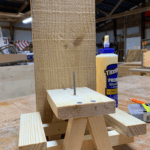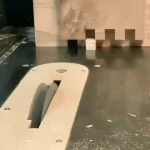Are you struggling with trying to figure out how to get tape off woodwork? It’s a common dilemma that homeowners and do-it-yourself enthusiasts often encounter, and it can be frustrating. Whether it’s painter’s tape, masking tape, or duct tape, removing tape from woodwork can be a daunting task. Fortunately, there are several methods and techniques that can make the process easier and help prevent damage to the woodwork.
Understanding the different types of tape that can be stuck on woodwork is crucial in knowing how to approach its removal. Each type of tape may require a different method for successful removal without causing damage. Before attempting to remove the tape, it’s important to prepare the woodwork properly. This includes cleaning the surface and assessing any potential damage that may have been caused by the adhesive.
One effective way to make tape removal easier is by using heat, which can help loosen the adhesive. Tools such as a hairdryer or heat gun can be employed for this purpose.
In addition to using heat, chemical solutions like adhesive removers or rubbing alcohol can also be used to dissolve the adhesive and aid in tape removal. And when all else fails, there are mechanical methods involving scraping tools, sandpaper, or razor blades that can be utilized to physically remove the tape from woodwork.
Understanding the Types of Tape
When it comes to removing tape from woodwork, it’s crucial to understand the different types of tape that can be stuck on wood surfaces. Whether it’s painter’s tape, masking tape, or duct tape, each type has its own adhesive properties and can present unique challenges when it comes to removal. Here’s a breakdown of these common types of tape and how to approach their removal from woodwork:
- Painter’s Tape: Painter’s tape is commonly used to achieve clean lines during painting projects. Its low-tack adhesive is designed to be easily removable without damaging the surface it’s adhered to. However, if left on for too long or exposed to extreme temperatures, painter’s tape can still leave behind residue on woodwork.
- Masking Tape: Masking tape has a stronger adhesive compared to painter’s tape and is often used for general purposes such as holding down protective coverings or securing items in place. Due to its stronger adhesion, removing masking tape from woodwork may require additional measures.
- Duct Tape: Duct tape is known for its incredibly strong adhesive and water-resistant properties. While it may not be recommended for use on delicate wood surfaces, accidents happen, and duct tape can end up stuck on woodwork. Removing duct tape from woodwork requires careful attention to avoid causing damage.
Regardless of the type of tape present on your woodwork, understanding its characteristics will help you choose the most effective method for removal without causing damage.
Before attempting to remove any type of tape from woodwork, it’s essential to prepare the surface properly.
- Cleaning: Start by cleaning the area around the taped section with a mild soap and water solution or a gentle cleaner appropriate for the type of finish on the woodwork.
- Assessing Damage: Once clean, assess whether any damage has occurred underneath the tape. Look for signs of discoloration, residue build-up, or any changes in the texture of the wood.
Preparing the Woodwork
When attempting to remove tape from woodwork, it is important to first prepare the surface before applying any removal methods. This will not only make the process easier but also minimize the risk of damaging the woodwork. Here are some tips on preparing the woodwork before attempting to remove the tape:
- Clean the Surface: Before removing the tape, it is essential to clean the surface of the woodwork. Use a mild cleaning solution and a soft cloth to remove any dust, dirt, or debris that may have accumulated on the surface. This will ensure that the adhesive on the tape is the only thing being targeted during removal.
- Assess for Damage: Carefully inspect the woodwork for any signs of damage or discoloration that may have occurred as a result of the tape being stuck for an extended period. Look for any residue left behind by the adhesive, as well as any scratches or marks caused by previous attempts at removing the tape.
Properly preparing the woodwork will set you up for success when attempting to remove tape without causing further damage. By ensuring that the surface is clean and free from any existing damage, you will be able to tackle the removal process with confidence.
Remember to take your time during this step to avoid rushing into it and potentially causing more harm than good. Once you have thoroughly prepared the woodwork, you can then proceed with using heat, chemical solutions, or mechanical methods to effectively remove the tape without compromising its integrity.
Using Heat
When dealing with tape stuck to woodwork, using heat can be an effective method to loosen the adhesive and make removal easier. Whether it’s painter’s tape, masking tape, or duct tape, these can all be stubborn to remove from wood surfaces. This section will guide you through the process of using heat, such as a hairdryer or heat gun, to safely and effectively remove tape from woodwork.
How Heat Helps
The application of heat helps to soften the adhesive on the tape, making it more pliable and easier to remove without damaging the woodwork. The gentle heat can also help release the bond between the tape and the wood surface, allowing for a smoother removal process.
Using a Hairdryer
One of the simplest ways to apply heat to tape on woodwork is by using a hairdryer. Hold the hairdryer several inches away from the tape and move it back and forth, focusing on small sections at a time. As the adhesive softens, use your fingers or a plastic scraper to gently peel off the tape. Repeat this process until all of the tape has been removed.
Using a Heat Gun
For tougher adhesives or larger areas of tape residue on woodwork, a heat gun can be used for more concentrated and intense heat application. It’s important to use caution when using a heat gun, as excessive heat can damage or discolor certain types of wood. Keep the heat gun moving constantly and at a safe distance from the wood surface to avoid any potential harm.
By following these tips and techniques on how to get tape off woodwork using heat, you can effectively remove stubborn adhesives without causing damage to your wooden surfaces. Taking your time and using gentle methods will help ensure that your woodwork remains undamaged while successfully removing any unwanted tape residues.
Chemical Solutions
When it comes to removing tape from woodwork, sometimes a little extra help is needed to effectively dissolve the adhesive and prevent damage to the surface. Chemical solutions such as adhesive removers or rubbing alcohol can be incredibly helpful in this process. These products work by breaking down the adhesive, making it easier to lift the tape off without leaving residue or causing damage to the wood.
Adhesive removers are specifically designed to dissolve sticky residues left behind by tapes and adhesives. They usually come in liquid form and can be applied directly to the affected area. Simply follow the instructions on the product label for best results.
Rubbing alcohol, on the other hand, is a common household item that can also be used to dissolve tape adhesive. It is effective at breaking down the stickiness of the adhesive, allowing for easier removal of the tape from woodwork.
It’s important to note that when using chemical solutions, especially on wooden surfaces, it’s crucial to test a small, inconspicuous area first to ensure that it doesn’t cause any discoloration or damage. Additionally, always follow safety precautions and use these products in a well-ventilated area. When using rubbing alcohol, avoid excessive use as it can potentially damage certain finishes or varnishes on woodwork.
| Chemical Solution | Usage |
|---|---|
| Adhesive Remover | Dissolves sticky residues left behind by tapes and adhesives |
| Rubbing Alcohol | Effective at breaking down the stickiness of tape adhesive |
Mechanical Methods
When it comes to removing tape from woodwork, there are several mechanical methods that can be used to effectively get the job done. These methods are particularly useful when dealing with stubborn adhesive residue or when the tape has been stuck on for an extended period of time. By using scraping tools, sandpaper, or razor blades, you can physically remove the tape and its residue without causing damage to the woodwork.
Scraping tools such as putty knives or paint scrapers can be used to gently lift and peel off the tape from the surface of the woodwork. It’s important to use these tools carefully to avoid scratching or gouging the wood. Sandpaper can also be used to smooth out any remaining adhesive after the tape has been removed. Start with a coarser grit sandpaper and gradually move to a finer grit to ensure that you don’t damage the wood.
Another effective method for removing tape residue from woodwork is using a razor blade. This method should be used with caution and only on surfaces that won’t be easily scratched. By carefully scraping the razor blade along the woodwork, you can remove any leftover adhesive without causing damage. Make sure to hold the razor blade at a shallow angle to minimize any potential scratches.
It’s important to remember that when using mechanical methods to remove tape from woodwork, patience is key. Take your time and work slowly and carefully in order to avoid causing any damage to the wood surface. By following these tips, you can effectively remove tape from woodwork without compromising its appearance.
Preventing Damage
When it comes to removing tape from woodwork, it’s essential to do so without causing any damage. The last thing any homeowner or DIYer wants is to end up with unsightly scratches or residue on their woodwork after trying to remove tape. This section will provide valuable tips and techniques for safely and effectively getting tape off woodwork.
Using Gentle Techniques
One of the best ways to prevent damage when removing tape from woodwork is by using gentle techniques. Rather than forcefully pulling at the tape, which can lead to splintering or scratching the wood, try using a more delicate approach. Gently peel back the tape at a 45-degree angle, taking care not to apply too much pressure.
Avoiding Residue Build-Up
Another common issue when removing tape from woodwork is dealing with sticky residue left behind. To avoid this problem, consider using a mild adhesive remover or rubbing alcohol to dissolve the remaining adhesive. Apply the solution to a cloth and gently dab at the residue until it begins to lift off the surface. Avoid using harsh chemicals that could potentially damage the wood.
Restoring the Woodwork
After successfully removing the tape without causing any damage, it’s important to restore the woodwork to its original condition. Use a gentle wood cleaner and a soft cloth to wipe away any remaining residue or marks left behind by the tape. Once clean, you can use a suitable polish or wax to restore shine and luster to the wood.
By following these tips and techniques, homeowners and DIYers can effectively remove tape from woodwork without causing any damage, ensuring a polished finish that looks as good as new.
Finishing Touches
After successfully removing the tape from the woodwork, it’s time to focus on the finishing touches that will ensure a polished and clean look. Once the adhesive has been removed and any potential damage has been assessed, it’s important to restore the woodwork to its original state. Here are some tips on how to achieve a polished finish.
First, clean the surface thoroughly with a mild cleaner or solvent to remove any remaining residue or dirt. This will ensure that the woodwork is free of any adhesive remnants and is ready for the next step. Be sure to use a gentle touch to avoid scratching or damaging the wood during this process.
Next, consider applying a wood polish or wax to restore shine and protect the surface of the woodwork. This will not only give it a glossy finish but also provide an extra layer of protection against future damage. Take care when applying these products, and follow the manufacturer’s instructions for best results.
Lastly, inspect the woodwork for any lingering damage or discoloration caused by the tape. If necessary, consider using touch-up stain or paint to blend in any affected areas and ensure a uniform appearance. By taking these extra steps, you can guarantee that your woodwork looks as good as new after removing the tape without causing further harm.
In conclusion, removing tape from woodwork can be a frustrating task, but with the right techniques and tools, it can be done effectively without causing damage. From using heat or chemical solutions to utilizing mechanical methods such as scraping tools or sandpaper, there are various ways to tackle this issue. By following these tips on preparing, cleaning, and restoring the woodwork after tape removal, you can achieve a polished finish that will leave your surfaces looking pristine.
Frequently Asked Questions
How Do You Get Sticky Tape Off a Wooden Door?
To get sticky tape off a wooden door, you can start by gently heating the tape with a hairdryer to soften the adhesive. Then, use a plastic scraper to carefully peel off the tape without damaging the wood.
How Do You Remove Sticky Residue From Wood Trim?
Removing sticky residue from wood trim can be done by applying some rubbing alcohol or a commercial adhesive remover onto a clean cloth and gently wiping the affected area. You may need to repeat this process until the residue is fully removed.
How Do You Remove Sticky Tape Residue?
Removing sticky tape residue can be achieved using common household items like rubbing alcohol, white vinegar, or even cooking oil. Simply apply a small amount of your chosen solution onto a cloth and gently rub the residue until it lifts off. Rinse with warm soapy water afterwards.

Hi everyone! I’m a woodworker and blogger, and this is my woodworking blog. In my blog, I share tips and tricks for woodworkers of all skill levels, as well as project ideas that you can try yourself.





